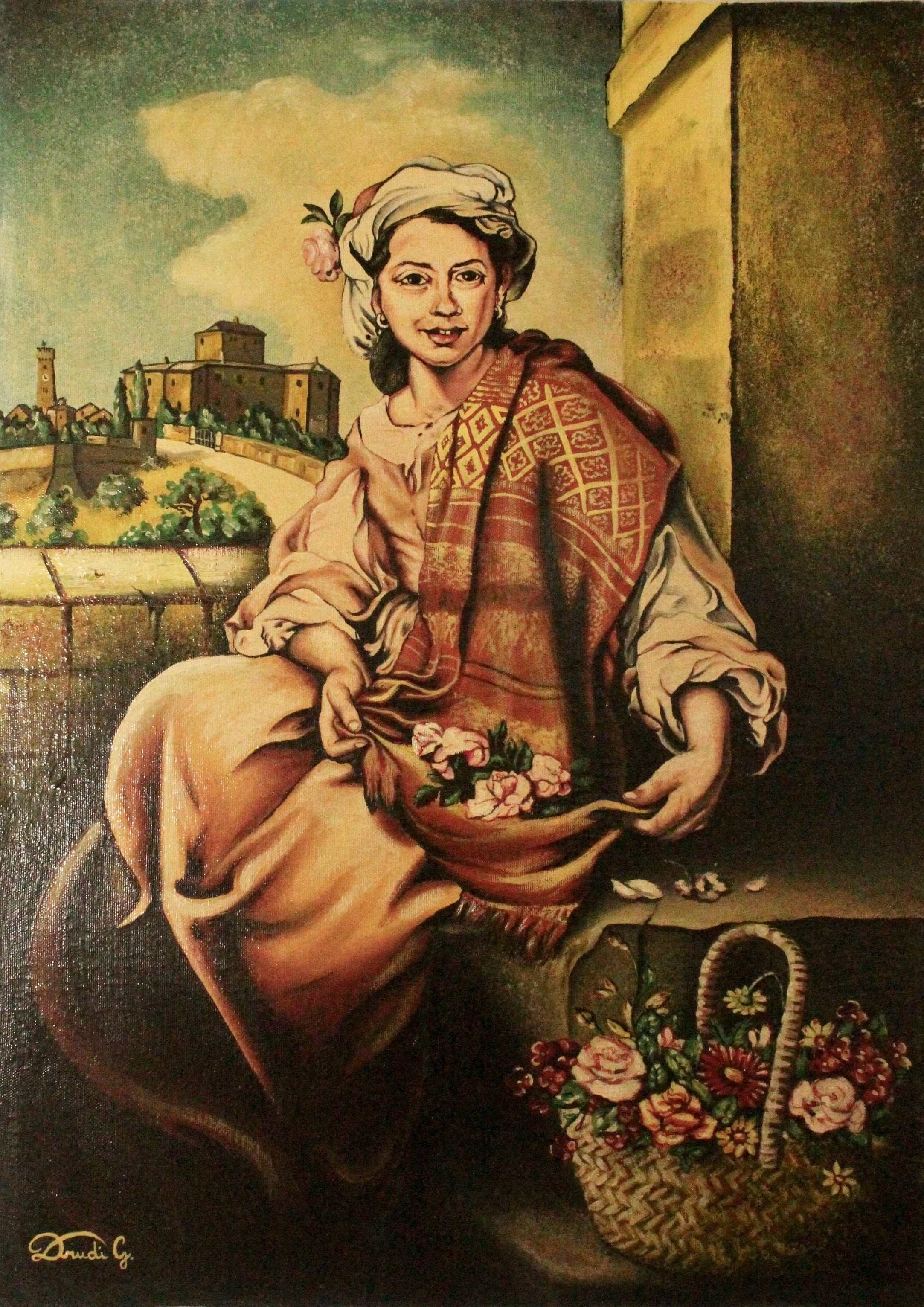THE FLOWER GIRL
1978, 50x70cm, Glossy oil on canvas

The beautiful flower girl seated with the town of Santarcangelo di Romagna in the background. A girl from another time.
This work from 1978 portrays a young flower girl sitting in a picturesque corner, with the historic village of Santarcangelo di Romagna behind her. The painting, with its realistic and detailed style, captures an atmosphere of bygone days, evoking the simplicity and grace of female figures from popular tradition.
Detailed description of the scene:
The flower girl
The protagonist is a young woman with a sweet face and expressive eyes, framed by a white headdress adorned with a flower. Her attire recalls the peasant fashion of the past: a garment in delicate tones and a large shawl decorated with geometric patterns, which covers her shoulder and part of her body, giving her an air of refined simplicity.
With a spontaneous gesture, she slightly lifts the shawl to gather some fresh flowers, almost wanting to proudly display them. Her serene yet intriguing gaze seems to be directed straight at the observer, inviting them to enter her world of natural scents and colors.
The setting:
The background is dominated by the hilly landscape with the village of Santarcangelo di Romagna, recognizable by its medieval towers and ancient walls. The winding road leading to the village suggests the link between rural life and town life, between the simplicity of the flower girl’s work and the daily life of the local community.
The symbolic elements:
Next to the young woman, a wicker basket full of colorful flowers symbolizes the ephemeral beauty of nature and the ancient trade of selling flowers. Some petals scattered on the ground suggest the passing of time and the delicacy of what is destined to fade.
Interpretation and meaning:
The painting celebrates the female figure in her natural beauty, portraying an era in which the simplicity of daily life was embellished by traditional trades. The flower girl, with her enigmatic gaze and gentle gesture, embodies the spontaneous elegance of women from the past, offering a nostalgic and poetic image of a time now distant.
The skillful use of light, which illuminates the girl’s face and floral details, gives the work an aura of sweetness and serenity, making it a tribute to the grace and simplicity of rural life.

The beautiful flower girl seated with the town of Santarcangelo di Romagna in the background. A girl from another time.
This work from 1978 portrays a young flower girl sitting in a picturesque corner, with the historic village of Santarcangelo di Romagna behind her. The painting, with its realistic and detailed style, captures an atmosphere of bygone days, evoking the simplicity and grace of female figures from popular tradition.
Detailed description of the scene:
The flower girl
The protagonist is a young woman with a sweet face and expressive eyes, framed by a white headdress adorned with a flower. Her attire recalls the peasant fashion of the past: a garment in delicate tones and a large shawl decorated with geometric patterns, which covers her shoulder and part of her body, giving her an air of refined simplicity.
With a spontaneous gesture, she slightly lifts the shawl to gather some fresh flowers, almost wanting to proudly display them. Her serene yet intriguing gaze seems to be directed straight at the observer, inviting them to enter her world of natural scents and colors.
The setting:
The background is dominated by the hilly landscape with the village of Santarcangelo di Romagna, recognizable by its medieval towers and ancient walls. The winding road leading to the village suggests the link between rural life and town life, between the simplicity of the flower girl’s work and the daily life of the local community.
The symbolic elements:
Next to the young woman, a wicker basket full of colorful flowers symbolizes the ephemeral beauty of nature and the ancient trade of selling flowers. Some petals scattered on the ground suggest the passing of time and the delicacy of what is destined to fade.
Interpretation and meaning:
The painting celebrates the female figure in her natural beauty, portraying an era in which the simplicity of daily life was embellished by traditional trades. The flower girl, with her enigmatic gaze and gentle gesture, embodies the spontaneous elegance of women from the past, offering a nostalgic and poetic image of a time now distant.
The skillful use of light, which illuminates the girl’s face and floral details, gives the work an aura of sweetness and serenity, making it a tribute to the grace and simplicity of rural life.